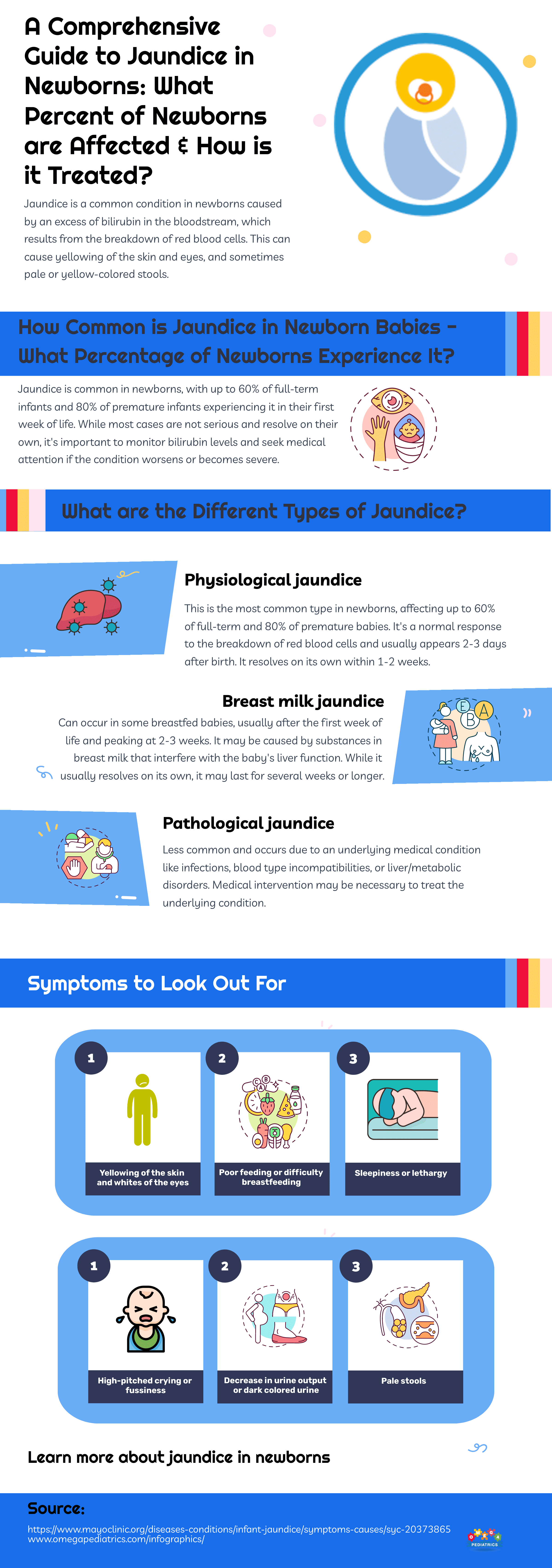Table of Contents
What is Jaundice and How Does it Impact the Health of Newborns?
Jaundice is a common medical condition that affects many newborns. It occurs when there is an overflow of bilirubin in the bloodstream, which is a yellow substance that is created when red blood cells are broken down. Jaundice causes the skin and whites of the eyes to turn yellow, and it can sometimes cause the baby’s stool to be pale or yellow as well.
In most cases, jaundice in newborns is a usual and brief condition that goes away without treatment. However, in some cases, it can be an indication of a more serious medical problem. Severe jaundice can cause a condition called kernicterus, which can head to brain damage and other complications.
Jaundice is usually first noticed in the first two to three days after birth, and it usually clears up within one to two weeks. It is more common in premature babies and in babies who are not breastfed. Breastfeeding can help prevent or reduce the severity of jaundice in newborns.
Treatment for jaundice may involve phototherapy, where the baby is placed under special lights to break down the excess bilirubin in the bloodstream, or in severe cases, a blood transfusion may be necessary.
If you suspect your newborn may have jaundice, it is important to consult a healthcare provider, who can perform a bilirubin test and provide guidance on the appropriate course of action.

How Common is Jaundice in Newborn Babies – What Percentage of Newborns Experience It?
Jaundice is a very common condition in newborn babies, with approximately 60% of full-term infants and 80% of premature infants experiencing some degree of jaundice in their first week of life. This means that the vast majority of newborns experience some level of jaundice, making it a very common condition. While most cases of jaundice are not serious and resolve on their own, it is important to monitor the baby’s bilirubin levels and seek medical attention if the condition worsens or becomes severe.
What are the Different Types of Jaundice and Symptoms to Look Out For
There are three main types of jaundice in newborns: physiological jaundice, breast milk jaundice, and pathological jaundice.
Physiological jaundice: This is the most common type of jaundice in newborns, affecting up to 60% of full-term babies and 80% of premature babies. It occurs as a normal response to the breakdown of red blood cells and typically appears 2-3 days after birth. Physiological jaundice typically resolves on its own within 1-2 weeks.
Breast milk jaundice: This type of jaundice can occur in some breastfed babies, usually appearing after the first week of life and peaking at 2-3 weeks. Breast milk jaundice may be caused by substances in the breast milk that interfere with the baby’s liver function. This type of jaundice usually resolves on its own but may last for several weeks or longer.
Pathological jaundice: This is a less common type of jaundice that occurs when there is an underlying medical condition that is causing the jaundice. Pathological jaundice can be caused by conditions such as infections, blood type incompatibilities between the mother and baby, or liver or metabolic disorders. Pathological jaundice may require medical intervention to treat the underlying condition.
The symptoms of jaundice in newborns include:
- Yellowing of the skin and whites of the eyes
- Poor feeding or difficulty breastfeeding
- Sleepiness or lethargy
- High-pitched crying or fussiness
- A decrease in urine output or dark, yellow-colored urine
- Pale stools
If you notice any of these symptoms in your newborn, it is important to contact your healthcare provider right away to determine the cause and appropriate treatment.
FAQ
What is Jaundice in Newborns?
Jaundice is a common condition in newborns caused by an excess of bilirubin in the bloodstream, leading to yellowing of the skin and eyes. It typically resolves on its own but can sometimes indicate a more serious issue.
How Common is Jaundice in Newborns?
Approximately 60% of full-term infants and 80% of premature infants experience some degree of jaundice in their first week of life, making it a very common condition among newborns.
What are the Different Types of Jaundice?
There are three main types of jaundice in newborns: physiological jaundice, breast milk jaundice, and pathological jaundice. Each type has different causes and may require different treatments.
What are the Symptoms of Jaundice in Newborns?
Symptoms of jaundice in newborns include yellowing of the skin and eyes, poor feeding, sleepiness, high-pitched crying, decreased urine output, and pale stools. If you notice any of these symptoms, it’s important to contact a healthcare provider.
How is Jaundice Treated in Newborns?
Treatment for jaundice may involve phototherapy, where the baby is exposed to special lights to break down excess bilirubin, or in severe cases, a blood transfusion may be necessary. It’s crucial to consult a healthcare provider for proper evaluation and treatment.



